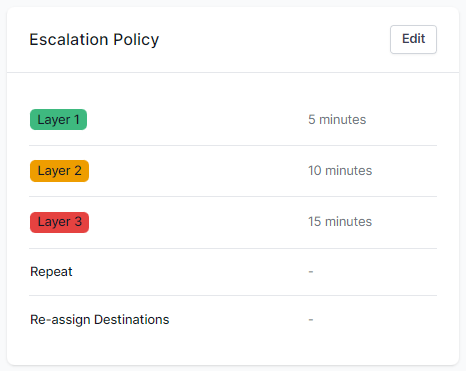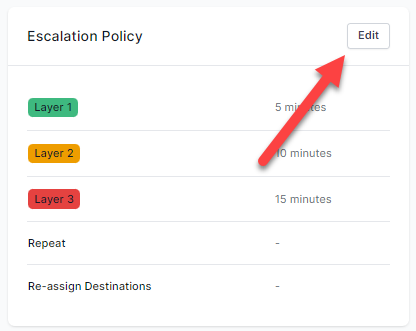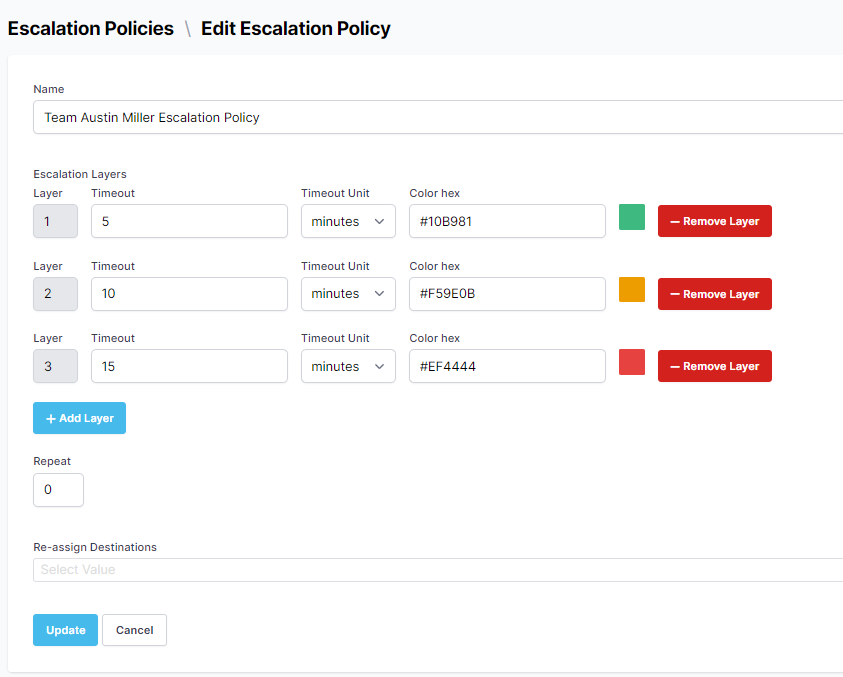Escalation Policies
What is an Escalation Policy?
A team's escalation policy defines the time each escalation layer will have (timeouts) to either acknowledge or reject an alert.

A team's escalation policy.
- If an account user acknowledges the alert (or the alert is auto resolved by an integration), no further escalation layers will be notified.
- If all users reject an alert or the timeout elapses it will be escalated to the next layer.
- When there are no more layers, PagerTree will
- check to see if there is a repeat option defined
- check to see if there is a reassign option defined
- If no repeat or reassign options have been exhausted, the alert will enter the
droppedstate.
Note: All repeat cycles will be performed before attempting to reassign the alert.
Escalation Layers
- An escalation policy can have 1..n escalation layers.
- Each escalation layer has configurable timeout associated with it.
Repeat Option
- If an alert has been escalated through all layers, PagerTree will check to see if a repeat should be performed.
- An alert can repeat an escalation policy between 0-3 times.
- If a repeat of 1-3 is defined, the alert will repeat the escalation layers starting at layer 1.
If a repeat is defined, the alert will move through the escalation N + 1 times. First, for the initial escalation policy, plus the number of repeats defined.
Reassign Option
- If an alert has been escalated through all layers and all repeats, PagerTree will check for the reassign option.
- If the reassign option is defined, the alert will be sent to the reassign destination. The alert will then flow through the reassign destinations workflow.
Edit Escalation Policy
To edit an escalation policy for a team:
-
Click the Edit button.

Edit Escalation Policy Button
-
Modify the escalation policy as needed.

Edit Escalation Policy Form
-
Click Update.
Examples
Alice, Bob, and Charlie are currently on-call for their team (Devops Team). Below is the definition of who is on-call for what layer, and the respective layer timeouts.
Devops Team Current On-Call Schedule and Escalation Policy:
- Layer 1 - 5m - Alice
- Layer 2 - 10m - Bob
- Layer 3 - 15m - Charlie
- Repeat 0x
- Reassign Destinations - None
Example 1 (Acknowledge)
- [minute 0] - The alert is routed to the team. Alice is notified of the alert.
- [minute 1] - Alice acknowledges the alert. The workflow stops and no other layers are notified.
Example 2 (Reject)
- [minute 0] - The alert is routed to the team. Alice is notified of the alert.
- [minute 1] - Alice rejects the alert. The alert is escalated to layer 2. Bob is notified of the alert.
- [minute 2] - Bob acknowledges the alert. The workflow stops and no other layers are notified.
Example 3 (Timeout)
- [minute 0] - The alert is routed to the team. Alice is notified of the alert.
- [minute 5] - Alice never responds to the alert. The alert times out of layer 1 and is escalated to layer 2. Bob is notified of the alert.
- [minute 7] - Bob acknowledges the alert. The workflow stops and no other layers are notified.
Example 4 (Drop)
- [minute 0] - The alert is routed to the team. Alice is notified of the alert.
- [minute 5] - Alice never responds to the alert. The alert times out of layer 1 and is escalated to layer 2. Bob is notified of the alert.
- [minute 15] - Bob never responds to the alert. The alert times out of layer 2 and is escalated to layer 3. Charlie is notified of the alert.
- [minute 30] - Charlie never responds to the alert. The alert times out of layer 3 and is escalated. Since, there are no more layers, and a repeat of 0x is defined, the alert status is changed to dropped.
Example 5 (No one on-call)
- [minute 0] - No one is on-call. The alert status is changed to dropped.
Example 6 (Repeat)
The follow example uses the above definition, with the exception that the Repeat is set to 1x.
- [minute 0] - The alert is routed to the team. Alice is notified of the alert.
- [minute 5] - Alice never responds to the alert. The alert times out of layer 1 and is escalated to layer 2. Bob is notified of the alert.
- [minute 15] - Bob never responds to the alert. The alert times out of layer 2 is escalated to layer 3. Charlie is notified of the alert.
- [minute 30] - Charlie never responds to the alert. The alert times out of layer 3 is escalated. Since, there are no more layers, and a repeat of 1x is defined, the alert is escalated to layer 1. Alice is notified of the alert.
- [minute 31] - Alice acknowledges the alert. The workflow stops and no other layers are notified.
Example 7 (Reassign)
The follow example uses the above definition, with the exception that the Reassign Destination is set to Executive Team.
- [minute 0] - The alert is routed to the team. Alice is notified of the alert.
- [minute 5] - Alice never responds to the alert. The alert times out of layer 1 and is escalated to layer 2. Bob is notified of the alert.
- [minute 15] - Bob never responds to the alert. The alert times out of layer 2 and is escalated to layer 3. Charlie is notified of the alert.
- [minute 30] - Charlie never responds to the alert. The alert times out of layer 3 and is escalated. Since, there are no more layers, and a repeat of 0x is defined, the alert is reassigned to the Executive Team. The alert will then notify users based on the Executive Team's schedule and escalation policy.